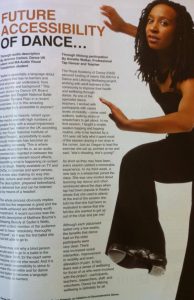Published on Dance UK‘s website Tue 28 May 2013 and in Dance UK‘s magazine issue 86/Autumn 2013
By Annette Walker, professional tap dancer and teacher
www.annettewalker.co.uk
I first heard about the Royal Academy of Dance’s ‘Dance for Lifelong Wellbeing’ project in early October 2012. The Royal Academy of Dance (RAD) had secured funding of nearly £50,000 for the project from the Skills Funding Agency to work with adult learners in the community and improve their health and wellbeing through dance. I happened to hear about it from Dr. Victoria Watts who was leading the project. Things progressed quickly and by the end of the month I found myself at the initial teacher training session as one of the specialist dance teachers of the project.
It was at this point that I realised that there might be specific needs to consider that I’d possibly taken for granted. What would I need to do in order to teach tap dance to older people? How do I teach tap dance to those who might not be able to walk?
There was ongoing support and encouragement from RAD Faculty of Education staff members who organised and prepared the teaching placements and research paperwork. A member of the team often attended sessions to observe and feedback to the specialist teachers. For my phase one placement it was reassuring to have the extra support even though the venue was a bright and cheerful nursing home with supportive and friendly staff.
The participants at the nursing home were a mixture of those who used walkers, walking sticks or wheelchairs to get about. After the initial visit I made an extra effort to visit the home before my first session so I could meet staff, physiotherapists and potential participants and observe their other movement-based classes.During this visit I had my first taste of teaching and taught a simple, seated clapping and tapping routine, only to be heckled by a 101-year old lady who’d spent most of the session dozing in her chair in the corner. Just as I began to lead the exercise she sat up, pointed at me and said, “she’s cheating, she’s young!” That was just the beginning of my initiation into some of the unexpected elements of an elderly dance group – quirks such as participants taking “power naps”, suddenly leaving midway through a session or commenting loudly on the exercises. But they were a warm and enjoyable group who I looked forward to teaching every week.
As short as they may have been, every session yielded a memorable experience. In my third class of phase one a new lady in a wheelchair joined the class. She was very excited about learning tap dance and often reminisced about the days tap dance had been popular in theatre shows that she used to attend.
At the end of the session she told me that she had been so motivated to dance that she felt like she wanted to get up out of the chair and join me. She told me her story, how she came to be in a wheelchair, how months of physiotherapy had not helped her to move her left leg. I wouldn’t have known this if she hadn’t said – she had been moving and tapping both feet throughout the session.
It wasn’t always obvious to tell if a participant was enjoying a class. Although many smiled and were openly excited about learning dance, others had fixed, somber expressions. One gentleman who attended all of my classes had a habit of commenting loudly to me during the sessions (he was hard of hearing). In the first session he exclaimed “ooooh, call the ambulance now” when I introduced a new warm-up movement. Nonetheless he always joined in with exercises. He even took upon himself to try some of the routines standing.
In the final session, a volunteer told me that although this particular gentleman always complained and resisted attending the sessions he always enjoyed himself. After the last class of phase one, he told me in his stern and somber manner, “you made everyone enjoy themselves. Serves them right!”
Although the placements were short (six weeks for phase one, eight weeks for phase two) the benefits that dance had on the older participants were very clear. There was increased social interaction, improvement in mobility and even alleviation of pain.
The ‘Dance for Lifelong Wellbeing’ project report will be published in July 2013, but based on response to the project there are already discussions on how to continue and sustain it. The project was the basis of a three-day conference at the RAD in April where we had the opportunity to share some of our experiences of the teaching research. There was a sense of wellbeing for those of us who were involved with the project. Participants, teachers, researchers, staff, volunteers… dance for lifelong wellbeing is definitely for all.
RAD ‘Dance for Lifelong Wellbeing’ Project:
Project manager: Dr. Victoria Watts (Royal Academy of Dance)
Researcher consultant: Dr Victoria Showumni (Institute of Education)
Specialist dance teachers: Lynn Blackman, Ana Jorge, Helen Linkenbagh, Sarah Platt, Hannah Powell, Annette Walker


